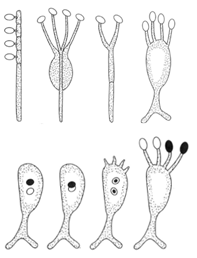The Basidiomycetes
 |
| Figure 20-1 Basidiospores are
most commonly formed on a clubshaped hypha, but also can take the form shown at left. In the lower right-hand corner, the fusion of nuclei to create the diploid condition, which is then followed by meiosis to produce haploid basidiospores. |
The Basidiomycetes are the “club fungi,” so-called because the sexual spores, called basidiospores, are borne on a club-shaped hypha, called the basidium. The typical number of basidiospores is four. Basidiomycetes includes mushrooms, toadstools, mildews, molds, smuts, rusts, puffballs, earth stars, bracket fungi, jelly fungi, bird’s nest fungi, and stinkhorns. Approximately 100,000 species have been described and perhaps twice that number await discovery. The class is divided into two subclasses, one of which includes the rusts and smuts, and the other of which includes the mushrooms, bracket fungi, and puffballs. The hyphae are septate but with a remaining central pore, which makes a continuous channel for cytoplasm between adjacent cells. The mycelium, which forms after the sexual cycle, is typically binucleated. Nuclear fusion occurs just prior to the formation of basidiospores, which are produced by meiotic divisions.




